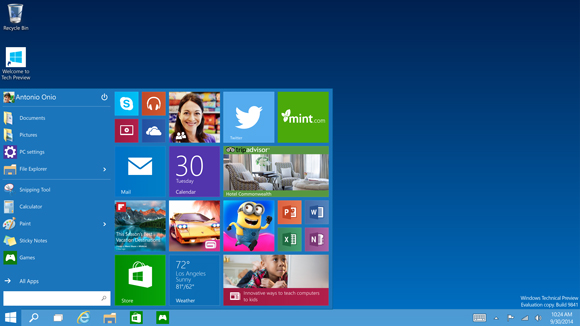Microsoft earlier this week revealed its new operating system, Windows 10, to the world.
But Redmond’s decision to avoid the Windows 9 name altogether, confused both experts and users alike – leading the company to explain its decision today.
Name Jump
Officially, Microsoft explained the decision to jump from Windows 8.1 straight through to Windows 10, avoiding Windows 9 altogether, was to emphasis the fact that the new operating system was totally new and will act a unifying platform for multiple devices.
But cynics suggested it was Redmond’s effort to distance the new OS from the relatively poor selling Windows 8, and to signify a fresh start.
 “Windows 10 represents the first step of a whole new generation of Windows, unlocking new experiences to give customers new ways to work, play and connect,” Microsoft’s Terry Myerson said earlier this week.
“Windows 10 represents the first step of a whole new generation of Windows, unlocking new experiences to give customers new ways to work, play and connect,” Microsoft’s Terry Myerson said earlier this week.
Yet this despite this grand sounding marketing like approach, the real reason could be a lot more mundane after a Microsoft developer posting on the social networking service Reddit suggested that a coding problem from the 1990s was actually to blame.
The developer, Cranbourne, suggested that the problem came down to a sloppy coding shortcut in third party products, that included program code pointing to Windows 9 (i.e. Windows 95 or Windows 98). This coding shortcut has apparently been used for a long time to differentiate between Windows 95 and 98, but it wouldn’t cope with a Windows 9.
This would of course have caused potential compatible issues if Microsoft had opted to use the Windows 9 moniker, because if systems saw a Windows version starting with the letter 9, it would assume it was for either Windows 95 or Windows 98.
“Microsoft dev here, the internal rumours are that early testing revealed just how many third party products that had code of the form,” wrote Cranbourne.
Cranbourne suggested that Microsoft’s decision to call its new OS Windows 10 “was the pragmatic solution to avoid that.”
Another developer, Christer Kaitila, meanwhile revealed that over 4,000 applications use that now-problematic coding shortcut.
Until Microsoft decides to comment officially however, this is all just speculation.
New Features
Besides the fact that Windows 10 is being touted as able to run on devices with a 4 inch screen, as well as platforms that have 80 inch screens, there are a number of other new developments with the new operating system.
The most notable change is the return of the familiar Start menu, which comes with a new customisable space for a user’s favourite apps and Live Tiles (from Windows Phone), where users can place their favourite apps, people and websites.
Redmond is also seeking to give users a more traditional Windows experience that incorporates both touch, keyboard, and mouse inputs.
Other new features include a search option on the taskbar and Start menu; a new quadrant app layout; and a new task-view button on the taskbar.
Users can also create multiple desktops for different purposes and projects For example users can create a desktop for the things they do at work, but also create a desktop for the things they do at home. Users can switch between these desktops easily and pick up where they left off on each desktop.
Do you know Microsoft Windows? Try our history quiz!




